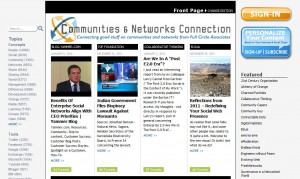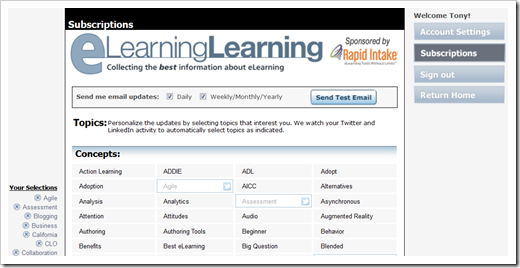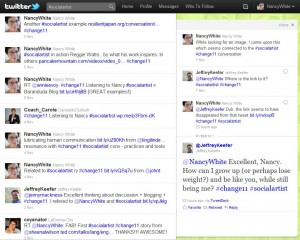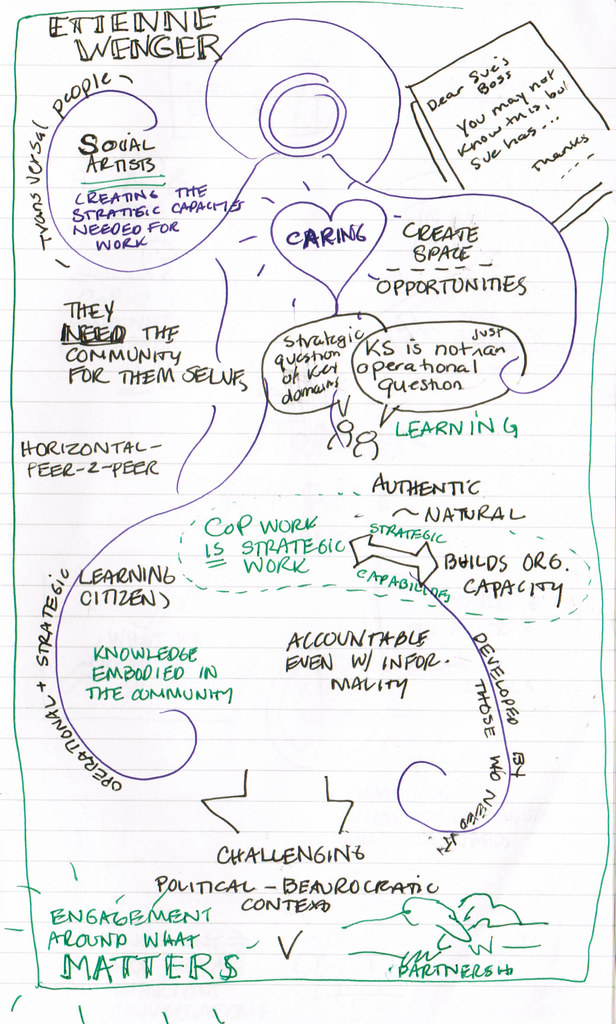 I’m continuing cleaning up and adapting my technology configuration this week. Here is part 2!
I’m continuing cleaning up and adapting my technology configuration this week. Here is part 2!
I confess, I don’t pay nearly enough attention to all the good things flying past me, including things on my own Communities and Networks Connection. In case this is new to you, this is an aggregation project led by Tony Karrer. He set up a system that lets me curate content from a wide variety of bloggers interested in communities and networks (If you aren’t on the list and want to be, drop me a line!). Tony just let me know that Aggregage, the platform that powers has some new features that are now on the Communities and Networks Connection. Announcing the PERSONALIZATION ENGINE! That means that Communities and Networks Connection now allows you to sign-up and have your content personalized based on their interests. You can sign-up via the “Personalize Your Content” button on the right side of the interface shown on the right side of the picture on the right (right, right?).
Tony has explained it well on his site, so I’m quoting the master. He refers to his own aggregation site, eLearning Learning
Now with personalization it’s even better. The picture below gives a sense of what’s happening:
Curators handle finding the best sources of content. The system then uses social signals such as those coming from Facebook, twitter, LinkedIn, delicious as well as clicks and views. These are compared to averages for the source and also looks at who is providing the signal, how often they signal things, how often they signal for that particular source, etc. Those aspects existed before and it does a good job of finding great content. You can read a bit more about these aspects in eLearning Learning Launches New Features.
What’s new now is that the site allows you to sign up and provide your Twitter and LinkedIn information. The site will look at your activity on these sites and the content of what you share. It will use that to find interests as well as to cluster you with other users who are like you based on interests and sharing. You can partially control your interests via the Subscription page as shown below:
This will change over time based on your LinkedIn and twitter activity. You can always visit and manually select interests as well. You can read a bit more here: Personalization Explained.
The system then can combine three pieces of information to figure out what will be most interesting to you:
- Social signal score – are people in the audience finding it interesting
- Topic match – does it match up with your interests
- Like sharing – are individuals who are like you sharing this
The system uses these to both rank things on the site and to generate Daily and Weekly newsletters.
The reason that I’m most exited about this is that I partly use eLearning Learning to make sure I don’t miss things that is good content that is relevant to me. Now with personalization, it is even less likely that something will sneak by.
I also personally like the format of the new newsletter.
Give it a try and let me know what you think.
So I’ll add my pitch – give it a try and let me know what you think. In the mean time, here is the best of Communities and Networks Connection 2011
- LAUREL PAPWORTH- SOCIAL NETWORK STRATEGY | TUESDAY, APRIL 26, 2011 8 ways to deal with negative comments in online communities
- How do you respond to a negative comment in an online community,on Facebook? Shut the Page down, ban the commenter, suck up to them? How about a bitchy tweet on Twitter? Fight with them? Ignore them? Promise to do better? PS: Your marketing intern may not have that skill! Click for larger size. Ignore the negative social media commenter. MORE >> 2945 Tweets
- ELSUA | WEDNESDAY, MAY 4, 20115 Reasons Why Activity Streams Will Save You From Information Overload I heart Activity Streams. mean, I * love* them to bits! From the very first beginning that I got exposed to them over at Twitter, over 4 years ago , till today, where I am using a bunch of various different microblogging / microsharing services, both internal and external, I couldn’t work, nor get much done!, without them. live them. Exactly! MORE >> 116 Tweets
- JENNY CONNECTED | SATURDAY, JUNE 11, 2011 Recording of Etienne Wenger’s talk Here is the link to the talk given by Etienne Wenger to Lancaster University, UK last month Learning in and across landscapes of practice. This is a long talk and there is a lot in it to digest. Theory. Theory in social sciences is a way of talking about the world. Theories that try to explain everything tend to be reductionist. Identity. MORE >> 31 Tweets
- JOITSKE HULSEBOSCH | MONDAY, MAY 9, 2011 Roles in communities of practice Does a learning community or community of practice need roles to function well? Should you officially assign these roles to people or is it best if people spontaneously fullfil certain roles? What about the self-organising power of communities? We thought it would be nice to share some of our thinking in this blogpost. Starting with ourselves. MORE >> 35 Tweets
- ALCHEMY OF CHANGE | TUESDAY, APRIL 26, 2011 How “Membranes” Build Great Organizations In this article, you’ll learn about a new way of thinking about organizational boundaries; one that helps connect what’s inside the organization with what’s outside it. You’ll also get a new framework for thinking about the way organizations engage customers, partners, and other organizations. The “Cellular Business”. Tweet. MORE >> 101 Tweets
- COLLABORATIVE THINKING | MONDAY, JANUARY 17, 2011 Activity Streams: Moving Beyond Event Aggregation
- When it comes to 2011 trends, I posted earlier on ” Enterprise 2.0: A Transition From Destination Site to Platform Services “. Rather than publish a short list, I wanted to take some time to explore each trend in more depth. In this post, I want to examine the topic of Activity Streams. Level of insight : Inconvenient truth beneath the hype. effort. MORE >> 65 Tweets
- FRESHNETWORKS | SUNDAY, JANUARY 23, 2011 15 essential articles for online community managers
- Image by moriza via Flickr. To celebrate the second annual Community Manager Appreciation Day , we’ve brought together 15 essential articles for online community managers and social media managers. This collection of articles, resources and thinking should have something for everybody to learn from or to add to. MORE >> 356 Tweets
- PORTALS AND KM | MONDAY, JANUARY 24, 2011 What Social Media and Enterprise 2.0 Can Bring to HR Processes
- Last week I had the pleasure of doing a webinar with the enterprise 2.0 software firm, Bitrix. We covered “The Business Value of Social Media and Enterprise 2.0” with an emphasis on HR process because of the audience. I want to share with you a bit of my thoughts from that session. Others have taken similar approaches. MORE >> 70 Tweets
- MICHAEL SAMPSON – CURRENTS | SUNDAY, MARCH 6, 2011 The Cost of SharePoint = License Fee x9 (It’s a Microsoft Figure)
- In response to my post about making SharePoint not look like SharePoint , Mike asked where the figure I quoted came from. He said: ” I would also like to see you cite your source for the statistic you quoted. The problem with statistics is that anyone can toss them out but unless you fully understand the context they are meaningless. My Comments. MORE >> 78 Tweets
- GREEN CHAMELEON | SUNDAY, MAY 29, 2011 Blog>> The Information Lifecycle
- It has been a while now that I talked about my experience of putting incentives for KM initiatives in place. These thoughts are very valid for global activities, though we are starting in our company to look at a second approach: implement knowledge sharing in people’s daily activities without imposing additional work. MORE >> 17 Tweets
- The Facebook Pages redesign – what’s changed and what does it mean? EMODERATION | MONDAY, FEBRUARY 14, 2011
- 7 Levels of Social Media Engagement LAUREL PAPWORTH- SOCIAL NETWORK STRATEGY | THURSDAY, MARCH 10, 2011
- The Social Enterprise – Welcome to the Era of Intrapreneurship! ELSUA | MONDAY, SEPTEMBER 5, 2011
- Value Creation in Communities of Practice JENNY CONNECTED | TUESDAY, JULY 12, 2011
- Various ways to use social media as a facilitator or trainer JOITSKE HULSEBOSCH | WEDNESDAY, MAY 11, 2011
- How People Define Smart Organizations: The Biology of Great Organizations Part II ALCHEMY OF CHANGE | TUESDAY, MAY 3, 2011
- Changing IT Mindsets From Deployment To Adoption COLLABORATIVE THINKING | MONDAY, JANUARY 24, 2011
- How do different age groups interact across the social web? FRESHNETWORKS | FRIDAY, JULY 8, 2011
- The Rising Need for Content Curation Skills and Capabilities. PORTALS AND KM | TUESDAY, MAY 10, 2011
- Innovation as an Emergent Property of a Value Network VALUE NETWORKS | MONDAY, MAY 30, 2011
- The sociable role of social reporters SOCIAL REPORTER | FRIDAY, APRIL 8, 2011
- Blog>> Knowledge Management in Intranets GREEN CHAMELEON | SUNDAY, JUNE 26, 2011
- What is the Value of a Tweet or Facebook Fan? LAUREL PAPWORTH- SOCIAL NETWORK STRATEGY | THURSDAY, APRIL 28, 2011
- How to Use Employee Engagement to Boost Your Business ELSUA | WEDNESDAY, MAY 18, 2011
- Attacks on connectivism JENNY CONNECTED | FRIDAY, FEBRUARY 25, 2011
- Twiitering = learning? JOITSKE HULSEBOSCH | TUESDAY, OCTOBER 11, 2011
- The Deep Science of Cooperation: Martin Nowak ALCHEMY OF CHANGE | THURSDAY, MAY 19, 2011
- Enabling Participation: More Art Than Science COLLABORATIVE THINKING | TUESDAY, JANUARY 25, 2011
- 22 social media management tools – a wiki in development FRESHNETWORKS | TUESDAY, JANUARY 18, 2011
- Putting Social Media to Work PORTALS AND KM | TUESDAY, SEPTEMBER 20, 2011
- All Work is Networked VALUE NETWORKS | MONDAY, JANUARY 24, 2011
- FOSI European Conference 2011 – social networks, education, privacy EMODERATION | WEDNESDAY, MAY 11, 2011
- Id Rather Be A Hammer Than A Nail or Nails Come in Boxes EVOLVING WEB | FRIDAY, NOVEMBER 4, 2011
- Media Trust explains how local news hubs will work SOCIAL REPORTER | WEDNESDAY, JUNE 15, 2011
- 9 Ways To Increase Your Productivity While Working From Home ELSUA | MONDAY, MAY 30, 2011
- Why Smart People are Reluctant to Share MICHAEL SAMPSON – CURRENTS | SUNDAY, JUNE 26, 2011
- So many learning style tests, so little time. JOITSKE HULSEBOSCH | TUESDAY, MAY 31, 2011
- A New Approach to Multi-Stakeholder Network Assessment NETWORKING ACTION | THURSDAY, MAY 5, 2011
- Enterprise 2.0: A Transition From Destination Site To Platform Services COLLABORATIVE THINKING | TUESDAY, JANUARY 4, 2011
- The social media landscape in 2011 – infographic FRESHNETWORKS | TUESDAY, MAY 31, 2011
- Social Enterprise Today: Useful New Content Aggregation Site PORTALS AND KM | THURSDAY, SEPTEMBER 29, 2011
- How do Social Networks Create Value? VALUE NETWORKS | TUESDAY, MAY 31, 2011
- Blog>> Brains Respond to Stories as if They Are Real GREEN CHAMELEON | TUESDAY, FEBRUARY 22, 2011
- New guidelines on how to keep online environments safe for children EMODERATION | TUESDAY, FEBRUARY 8, 2011
- Presenting to myself on collaboration and social innovation SOCIAL REPORTER | MONDAY, JANUARY 17, 2011
- KM, Enterprise 2.0 and Social Business: One and The Same ELSUA | MONDAY, MARCH 28, 2011
- Defining Collaboration – 2. Four Types of Work MICHAEL SAMPSON – CURRENTS | WEDNESDAY, FEBRUARY 23, 2011
- Twitter for organisations JOITSKE HULSEBOSCH | TUESDAY, FEBRUARY 22, 2011
- Launching the Personal Kanban Book EVOLVING WEB | FRIDAY, FEBRUARY 4, 2011
- meeting formats JOHN TROPEA – DELICIOUS FACILIATATION | FRIDAY, OCTOBER 14, 2011
Hot Topics for 2011
2011 (4593)
People (2501)
Social (2225)
Share (1603)
Sharing (1603)
World (1555)
Change (1546)
Networks (1534)
Community (1515)
Difference (1467)
Business (1431)
Development (1425)
Management (1349)
May (1324)
Media (1298)
Information (1296)
Open (1240)
P2P (1220)
Learning (1191)
Groups (1181)






 So, what is a social artist and why did I think it might be relevant to #Change11? I’m not sure we landed on a clear definition. I started with the concept I borrowed from Etienne Wenger-Trayner, who has talked about the social artist as a person who makes the space for the social aspect of learning. Here is a quote from him from 2008 on
So, what is a social artist and why did I think it might be relevant to #Change11? I’m not sure we landed on a clear definition. I started with the concept I borrowed from Etienne Wenger-Trayner, who has talked about the social artist as a person who makes the space for the social aspect of learning. Here is a quote from him from 2008 on